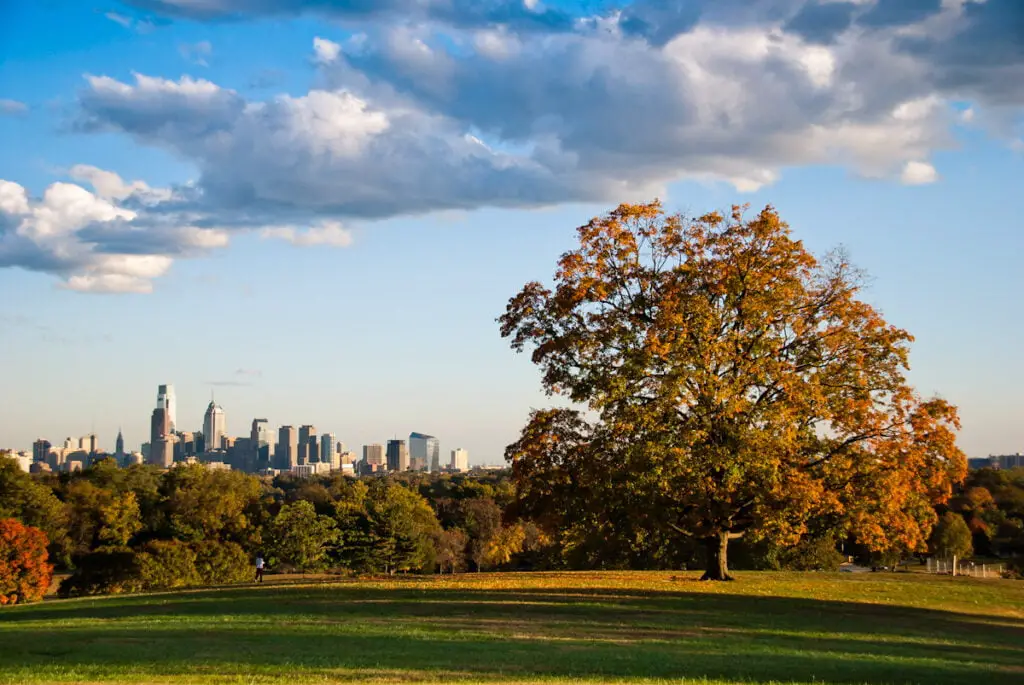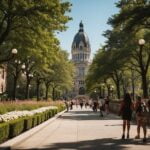Nestled along the scenic banks of the Schuylkill River, Fairmount Park emerges as Philadelphia’s verdant sanctuary, offering a harmonious blend of history, culture, and natural beauty. Established in the 19th century as a response to the city’s industrialization, the park has evolved into one of the largest urban green spaces in the United States. Its rich history unfolds through time, with historic mansions and iconic landmarks, showcasing the enduring commitment to preserving Philadelphia’s architectural and cultural heritage.
Fairmount Park’s allure extends beyond its historical significance, as it stands as a testament to the city’s dedication to green urban planning. The park is a sprawling canvas of outdoor possibilities, inviting visitors to explore a network of trails, enjoy recreational activities, and relish moments of tranquility against a stunning backdrop. Whether jogging along tree-lined paths or picnicking by the riverbanks, Fairmount Park offers an escape into nature without leaving the heart of the city.
Home to cultural institutions like the Philadelphia Museum of Art and the Please Touch Museum, Fairmount Park is more than just a haven for outdoor enthusiasts. It’s a vibrant hub for artistic expression and family-friendly activities. The park’s calendar is filled with events and festivals, providing a dynamic space for community engagement, live performances, and celebrations throughout the year. As a committed steward of the environment, Fairmount Park not only serves as a recreational haven but also champions sustainability, contributing to the preservation of the city’s natural ecosystems.
Embark on a journey through Fairmount Park – where the past meets the present, and nature intertwines with culture. This urban oasis beckons, inviting all to explore its iconic landmarks, revel in outdoor adventures, and immerse themselves in the cultural tapestry that defines Philadelphia’s green gem.
Table of Contents
Historical Significance
Fairmount Park’s historical significance traces back to the 19th century, a pivotal era when Philadelphia grappled with the consequences of rapid industrialization. Born from a collective desire to counterbalance urban development, the park was established as an ambitious green initiative. Its expansive grounds, spanning over 2,000 acres, became a sanctuary preserving nature amid the burgeoning cityscape.
The park’s roots intertwine with the City Beautiful movement, a progressive urban planning philosophy that sought to enhance civic life through aesthetic design and the integration of natural elements. Philadelphia’s visionaries recognized the need for a vast green space to counter the environmental and social challenges posed by industrial expansion. As a result, Fairmount Park emerged, evolving into a grand testament to the city’s commitment to providing its residents with a harmonious blend of urban and natural environments.
Key to the park’s historical tapestry are its stately mansions, such as the Lemon Hill and Strawberry Mansion, which stand as architectural relics of a bygone era. Originally private estates, these structures now serve as windows into Philadelphia’s past, offering glimpses of the opulent lifestyles of the city’s elite. These historic buildings, nestled within the park’s expanse, embody the preservation efforts undertaken to safeguard Philadelphia’s architectural heritage.
Beyond its architectural marvels, Fairmount Park also played a pivotal role in the early development of waterworks systems. The Fairmount Water Works, an iconic structure along the Schuylkill River, once served as a technological marvel that supplied clean water to the city. Today, this site serves as a museum, preserving the memory of Philadelphia’s innovative strides in urban infrastructure.
In essence, Fairmount Park stands not only as a sprawling green haven but also as a living testament to Philadelphia’s foresight and commitment to preserving its historical, cultural, and natural legacy amid the ever-evolving urban landscape. The park’s historical significance is etched into its landscapes, structures, and the enduring spirit of civic stewardship that shaped its creation.
Iconic Landmarks
Fairmount Park boasts a tapestry of iconic landmarks that not only define its landscape but also contribute significantly to Philadelphia’s cultural identity. At the forefront stands the Philadelphia Museum of Art, a monumental institution perched majestically at the end of Benjamin Franklin Parkway. The museum is not only a beacon for art enthusiasts but also a symbol immortalized by the iconic “Rocky Steps,” drawing visitors to ascend in the spirit of the legendary movie character.
Along the serene banks of the Schuylkill River, Boathouse Row presents a captivating spectacle. This historic site comprises a line of 19th-century boathouses, each uniquely designed and illuminated, creating a picturesque scene that reflects on the river’s tranquil surface. These boathouses are not just architectural gems but also a testament to the city’s rich rowing heritage and vibrant recreational culture.
Venturing further into Fairmount Park unveils historic mansions that add a touch of grandeur to the landscape. Strawberry Mansion, with its Federal-style architecture, and Lemon Hill, surrounded by terraced gardens, harken back to an era when these estates were private retreats for Philadelphia’s elite. Today, they stand open to the public, offering a glimpse into the city’s aristocratic past and architectural splendor.
The Shofuso Japanese House and Garden, a serene retreat nestled within the park, provides a unique cultural experience. This traditional Japanese house, surrounded by meticulously landscaped gardens, transports visitors to another world, showcasing the delicate beauty of Japanese design against the backdrop of Fairmount Park’s natural scenery.
Fairmount Park’s iconic landmarks are not merely structures; they embody the city’s history, cultural diversity, and commitment to preserving both architectural and natural heritage. Whether ascending the museum steps, strolling along Boathouse Row, or exploring historic mansions, each landmark tells a story, inviting visitors to immerse themselves in the rich tapestry of Philadelphia’s past and present.
Outdoor Recreation
Fairmount Park stands as an expansive playground for outdoor enthusiasts, offering a diverse array of recreational opportunities that seamlessly blend with the park’s natural beauty. For fitness enthusiasts and nature lovers alike, the park’s extensive network of trails provides an ideal setting for jogging, cycling, or leisurely strolls. As visitors traverse these pathways, they are treated to scenic vistas, lush greenery, and the soothing sounds of the Schuylkill River, creating a rejuvenating escape within the heart of the city.
Cyclists can explore dedicated biking trails, navigating through wooded areas and open spaces that cater to both novice riders and seasoned cyclists. The park’s bike-friendly infrastructure ensures a safe and enjoyable experience, with routes that showcase the park’s diverse landscapes, from dense forests to open meadows.
Picnic areas scattered throughout Fairmount Park invite families and friends to gather for a day of relaxation and enjoyment. The riverbanks provide serene spots for picnicking, with picturesque views of the water and the city skyline serving as a backdrop. These green expanses become communal spaces for socializing, outdoor games, and basking in the tranquility of nature.
The park’s commitment to recreation extends to its sports facilities, including basketball courts, soccer fields, and playgrounds. These spaces cater to various interests and age groups, promoting an active and inclusive environment. Families can engage in friendly matches, children can explore play structures, and sports enthusiasts can partake in organized activities, fostering a sense of community within the park’s vast grounds.
Water-based activities further enrich Fairmount Park’s recreational offerings. Kayaking along the Schuylkill River provides a unique perspective of the city, combining the thrill of water adventure with the serenity of the natural surroundings.
In essence, Fairmount Park transcends its role as a mere green space; it transforms into an urban oasis where outdoor recreation becomes a harmonious blend of nature, physical activity, and community engagement. Whether seeking an invigorating run, a leisurely bike ride, or a family picnic, Fairmount Park offers a diverse range of outdoor experiences, inviting all to savor the beauty of Philadelphia’s expansive green haven.
Cultural Institutions
Fairmount Park serves as a cultural haven within the heart of Philadelphia, housing a diverse array of institutions that enrich the city’s artistic and educational landscape. Foremost among these is the renowned Philadelphia Museum of Art, a bastion of creativity that beckons visitors with its vast collection spanning centuries and continents. From classical masterpieces to contemporary works, the museum stands as a testament to the city’s commitment to fostering artistic expression and appreciation.
Adjacent to the museum, the Rodin Museum showcases an extensive collection of sculptures by the French master Auguste Rodin. The serene outdoor setting, adorned with these timeless creations, provides a contemplative space for art enthusiasts to immerse themselves in the beauty of sculptural artistry.
For families and the young at heart, the Please Touch Museum offers a dynamic and interactive experience. Designed specifically for children, this hands-on museum encourages learning through play, sparking curiosity and creativity in a vibrant and engaging environment.
Fairmount Park extends its cultural offerings beyond traditional museums with attractions like the Shofuso Japanese House and Garden. This tranquil retreat transports visitors to Japan, featuring a traditional Japanese house surrounded by meticulously landscaped gardens. The Shofuso experience provides a cultural journey within the park, showcasing the beauty and serenity of Japanese design.
The park’s commitment to cultural diversity is further exemplified by the Mann Center for the Performing Arts. Nestled amid the greenery, this outdoor venue hosts a variety of concerts, live performances, and cultural events, transforming Fairmount Park into a vibrant stage for artistic expression and community gatherings.
Fairmount Park’s cultural institutions collectively contribute to the city’s identity as a hub of artistic and educational excellence. Whether exploring world-class art collections, engaging in interactive exhibits, or enjoying live performances, visitors to Fairmount Park can embark on a cultural journey that reflects the rich tapestry of Philadelphia’s creative spirit.
Events and Festivals
Fairmount Park comes alive throughout the year with a dynamic calendar of events and festivals, creating a vibrant tapestry of community engagement and cultural celebration. From lively outdoor concerts to captivating art festivals, the park becomes a hub of activity, inviting visitors to partake in a myriad of experiences that showcase the diversity and creativity of Philadelphia.
During the warmer months, the park hosts an array of outdoor concerts that resonate through the open spaces, filling the air with music that caters to diverse tastes. From classical ensembles to contemporary performances, the park’s natural amphitheaters provide an idyllic setting for music enthusiasts to enjoy live performances under the open sky.
Art enthusiasts converge on Fairmount Park during annual festivals that celebrate creativity in various forms. Whether it’s a showcase of local artists, interactive exhibits, or outdoor installations, these festivals transform the park into a dynamic gallery, fostering a sense of artistic exploration and community connection.
Seasonal celebrations, such as Fourth of July festivities and holiday events, turn Fairmount Park into a gathering place for families and friends. Fireworks illuminate the night sky, and the park becomes a canvas for light displays and seasonal decorations, creating a festive atmosphere that brings the community together to celebrate special occasions.
For foodies and culinary enthusiasts, food festivals showcase the city’s diverse gastronomic offerings. From food truck gatherings to culinary showcases featuring local chefs, Fairmount Park becomes a culinary destination, offering a feast for the senses amid the natural beauty of the surroundings.
Cultural and heritage festivals add another layer of diversity to the park’s event calendar. These celebrations highlight the city’s multicultural identity, featuring music, dance, and traditions that pay homage to Philadelphia’s rich tapestry of communities.
Fairmount Park’s events and festivals not only provide entertainment but also serve as a platform for community building. They create spaces where residents and visitors alike can come together, share experiences, and revel in the dynamic spirit that defines Philadelphia’s cultural landscape. As the park transforms into a canvas for these diverse events, it solidifies its status as a living, breathing cultural hub within the heart of the city.
Environmental Stewardship
Fairmount Park stands as a shining example of environmental stewardship, embodying a commitment to sustainability and the preservation of natural ecosystems within an urban setting. As one of the largest municipal parks in the United States, Fairmount Park’s dedication to environmental conservation is woven into its fabric, creating a harmonious balance between nature and the city.
The park’s extensive green spaces serve as a vital lung for Philadelphia, providing a sanctuary for diverse plant and animal species. Ongoing efforts in ecological restoration ensure the preservation of native flora, contributing to the overall biodiversity of the region. Native plantings, habitat restoration projects, and sustainable landscaping practices exemplify the park’s dedication to maintaining a healthy and resilient ecosystem.
Fairmount Park plays a crucial role in water management, with the presence of the historic Fairmount Water Works serving as a reminder of the park’s connection to the Schuylkill River. Stormwater management initiatives and green infrastructure projects help mitigate the impact of urban runoff, fostering cleaner waterways and healthier aquatic habitats.
The park’s emphasis on sustainable practices extends to waste management and recycling programs. Education and awareness campaigns encourage visitors to minimize their environmental footprint, promoting responsible waste disposal and recycling habits. Through these initiatives, Fairmount Park aims to instill a sense of environmental responsibility among its visitors, creating a collective effort towards a greener future.
As a living laboratory for environmental education, Fairmount Park offers interpretive programs and guided tours that highlight the importance of ecological preservation. From bird watching to nature walks, these initiatives engage the community in understanding and appreciating the natural world, fostering a sense of environmental stewardship among park-goers.
Fairmount Park’s commitment to sustainability aligns with broader citywide initiatives, positioning it as a leader in urban environmental conservation. By seamlessly integrating green spaces with responsible practices, the park not only provides a refuge for residents but also sets a precedent for how urban environments can coexist harmoniously with nature, inspiring cities around the world to prioritize environmental stewardship within their own landscapes.
Nearby Attractions
Nestled in the heart of Philadelphia, Fairmount Park not only offers its visitors a plethora of attractions within its expansive grounds but also serves as a gateway to a diverse array of nearby points of interest. Whether you seek historical landmarks, cultural institutions, or vibrant neighborhoods, the surrounding areas complement the park’s allure, inviting exploration beyond its green expanses. From iconic museums to charming districts, here’s a curated list of 15 nearby attractions that promise to enhance your Philadelphia experience.
Nearby Attractions:
- Philadelphia Museum of Art: A short stroll from Fairmount Park, this world-renowned institution beckons art enthusiasts with its vast and diverse collection.
- Rodin Museum: Admire the sculptural masterpieces of Auguste Rodin in this intimate museum located near the Philadelphia Museum of Art.
- Boathouse Row: Along the Schuylkill River, the historic boathouses illuminate the waterfront, providing a picturesque scene for a leisurely stroll.
- Eastern State Penitentiary: Delve into history at this former prison turned museum, offering guided tours that reveal its intriguing and haunting past.
- The Barnes Foundation: Home to an impressive collection of art, including works by Cézanne, Renoir, and Matisse, this gallery is a cultural gem in the city.
- Philadelphia Zoo: Just a short drive away, the nation’s first zoo promises an exciting day of wildlife encounters and family-friendly activities.
- Fairmount Water Works: Explore the historic waterworks and learn about Philadelphia’s innovative approach to water supply and distribution.
- The Franklin Institute: Engage in interactive science exhibits and immersive experiences at this renowned science museum and planetarium.
- Benjamin Franklin Parkway: A grand boulevard lined with museums, sculptures, and fountains, providing a scenic route for exploration.
- Rittenhouse Square: Located in the heart of Center City, this charming park offers a serene retreat with tree-lined paths and a picturesque fountain.
- Reading Terminal Market: Immerse yourself in the vibrant culinary scene at this historic market, offering an array of fresh produce, artisanal goods, and diverse dining options.
- Mutter Museum: A fascinating and unique experience awaits at this medical museum, known for its collection of medical oddities and historical artifacts.
- Philadelphia’s Magic Gardens: Discover an immersive mosaic art environment created by artist Isaiah Zagar, showcasing the beauty of found objects and recycled materials.
- Chinatown: Experience the rich cultural heritage of Philadelphia’s Chinatown with its authentic cuisine, vibrant markets, and cultural events.
- Spruce Street Harbor Park: Along the Delaware River, this seasonal park features floating gardens, hammocks, and a boardwalk, creating a lively and relaxing waterfront destination.
Conclusion
In conclusion, Fairmount Park in Philadelphia is not just a green oasis; it is a multifaceted gem that weaves together history, culture, and nature, creating a tapestry that resonates with both locals and visitors alike. From its roots as a response to industrialization in the 19th century to its evolution into one of the nation’s largest urban parks, Fairmount Park stands as a testament to Philadelphia’s commitment to preserving its heritage and providing a sanctuary for community engagement.
As you traverse the park’s scenic trails, explore its iconic landmarks, and partake in the myriad of cultural and recreational activities it hosts, it becomes evident that Fairmount Park is more than just a destination – it’s a living, breathing testament to the city’s dynamic spirit. Beyond its borders, the nearby attractions enhance the overall experience, offering a rich tapestry of museums, historical sites, and vibrant neighborhoods that further enrich the Philadelphia adventure. Whether you’re drawn to the artistry of the Philadelphia Museum of Art, the serenity of Boathouse Row, or the historical allure of Eastern State Penitentiary, the surrounding areas seamlessly complement the allure of Fairmount Park, inviting exploration and discovery in every direction. In Fairmount Park, history meets contemporary culture, and the urban landscape harmonizes with nature, creating an experience that encapsulates the essence of Philadelphia’s past, present, and future.






1 thought on “Exploring Fairmount Park: Philadelphia’s Green Oasis”
Comments are closed.